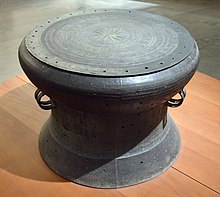Dong Son drum
Dong-Son drums are considered to be the most important bronze artifacts of the Dong-Son culture , dating from around 800 BC. Existed in northern Vietnam and in southern China .
General
These bronze drums or kettle gongs were distributed throughout Southeast Asia via trade routes as far as New Guinea . 140 ancient Dong-Son drums are known from Vietnam alone , around 20 examples were discovered on the islands of the Malay Archipelago , for example a particularly well-preserved Dong-Son drum in East Timor in 2015 , weighing 80 kg and an estimated age of 2000 years . The specimens found furthest east were discovered on the Vogelkop Peninsula of New Guinea. Later cultures from Inner Mongolia to eastern Indonesia adopted the idea of the bronze drums. Examples include the Frog drums of Karen or Mokos of the Lesser Sunda Islands .
Small models of drums made of clay or bronze were used as grave goods.
The drums still have cultural significance in the Vietnamese province of Hà Giang , where they are kept as family heritage in rural villages.
One of the largest collections of bronze drums can be found in the National Museum of History in Hanoi .
Appearance and classification
The Dong-Son drums have a bulbous shape and show a star-shaped engraving in the center of the "eardrum". There are also geometric patterns and depictions of soul ships with which the deceased get to the afterlife, houses, mammals, fish and people. Some specimens have four frogs on the drum, some also have a handle in the middle of the drum.
The ethnologist Franz Heger divided the Dong-Son drums into four different types in 1902, with the Heger Type I (HI) drums representing the oldest form of bronze drums in Vietnam and dating from the Dong-Son period itself. The distinction is made on the basis of shape and decoration. In 1990 the Vietnamese scientist Pham Huy Thong divided this type I into five subgroups based on chronological criteria. The oldest group A includes large drums with intricate decorations. The drums of group B are smaller and have a group of flying water birds on the "eardrum" and the sound body as the main motif. Feathered warriors can be found in group C as the central element of the "eardrum", framed by a group of flying water birds. Frog figures sit around the edge of the "eardrum". The body of the drum is decorated with boats and geometric patterns. Other Vietnamese scientists also divided the Heger Type I according to different criteria, since this was the type that was mainly found in northern Vietnam.
Chinese scholars have been criticizing Heger's system since the 1950s, believing that Heger did not have enough exhibits to properly classify. They rearranged the system, especially the chronological order. According to these systems, the original Heger Type II drums were the oldest. It is noticeable that Heger Type II drums were found mainly in the Chinese province of Guangxi and that their decorations were similar to those from the central plains of China, which led to criticism from Vietnamese scientists. The Museum of Chinese Yunnan , however, stuck to Heger's order. After numerous Heger I type drums were found in Southeast China in the mid-1970s, some of them even more archaic than those in Vietnam, Chinese scientists also returned to Heger's chronology, with the difference that the newly discovered Wanjiaba drums were classified as the oldest. According to this, the Chuxiong Prefecture in Yunnan would be the origin of the bronze drums in Southeast Asia.
A view that Vietnamese scientists such as Pham Huy Thong do not share. The Chinese assessment that drums are older the simpler the decoration is, is considered wrong by the Vietnamese side. Pham Huy Thong even sees the Wanjiaba drums as the youngest within the Heger Type I.
literature
- Franz Heger : Old metal drums from Southeast Asia. Hiersemann, Leipzig 1902
- AJ Bernet Kempers: The Kettledrums of Southeast Asia. A Bronze Age World and its Aftermath. In: Gert-Jan Bartstra, Willem Arnold Casparie (ed.): Modern Quarternary Research in Southeast Asia, Vol. 10. AABalkema, Rotterdam 1988, ISBN 978-9061915416
- Andreas Reinecke: Bronze Drums - Living and Dying on the Red River . In: Spektrum der Wissenschaft 12/2016 pp. 67–73.
- ML Tjoa-Bonatz, Andreas Reinecke: Treasures of the archeology of Vietnam. Accompanying volume for the special exhibition. Nünnerich-Asmus, Mainz 2016
Web links
Individual evidence
- ↑ a b c d Han Xiaorong: The Present Echoes of the Ancient Bronze Drum: Nationalism and Archeology in Modern Vietnam and China , Explorations in Southeast Asian Studies, a Journal of the Southeast Asian Studies Student Association, Vol 2, No. 2, case 1998 , accessed November 22, 2015.
- ↑ Sapo.tl: Tambor Dong Son vietnamita com cerca de 2000 anos found in Timor-Leste , November 18, 2015 , accessed on November 18, 2015.
- ^ Sue O'Connor: Nine New Painted Rock Art Sites from East Timor in the Context of the Western Pacific Region , pp. 19 ff., Asia Perspectives, Vol. 42, No.1, 2003 , accessed April 6, 2020.
- ↑ Drum model with four frogs, Dongson culture, 300 bc – 200 ad The Metropolitan Museum of Art
- ↑ a b c d Pham Minh Huyen: A Typological Study of Bronze Drums in the Ha Giang Museum , ( Memento of July 23, 2008 in the Internet Archive ) Institute of Archeology, Hanoi.
- ^ Richard M. Cooler: The Karen Bronze Drums of Burma , Brill 1995.
- ^ Higham, Charles (1996). The Bronze Age of Southeast Asia. Cambridge World Archeology. ISBN 0-521-56505-7 .
- ↑ Pham Huy Thong, Pham Minh Huyen and Lai Van Toi (eds.): Dong Son drums in Vietnam , Hanoi 1990.

